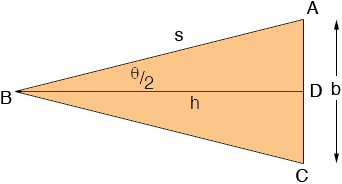| |||
| Math Central | Quandaries & Queries |
|
Question from Ahlee, a student: So my question is: |
Ahlee,
I can get you started.

From the diagram h = s × cos(θ/2) and |AD| = b/2 = s × sin(θ/2). Thus the area of the triangle is
A = 1/2 b × h = s × sin(θ/2) ×cos(θ/2)
But the double angle formula for sin(t) is
sin(2t) = 2 sin(t) × cos(t)
and hence the area of the triangle is
A = 1/2 b × h = s × sin(θ/2) × cos(θ/2) = s/2 × sin(θ)
Now apply the calculus you know to find the relationship between dA/dt and dθ/dt.
Penny
 |
||
Math Central is supported by the University of Regina and The Pacific Institute for the Mathematical Sciences.